engine overheat Oldsmobile Cutlass 1998 Owner's Manuals
[x] Cancel search | Manufacturer: OLDSMOBILE, Model Year: 1998, Model line: Cutlass, Model: Oldsmobile Cutlass 1998Pages: 348, PDF Size: 17.46 MB
Page 81 of 348
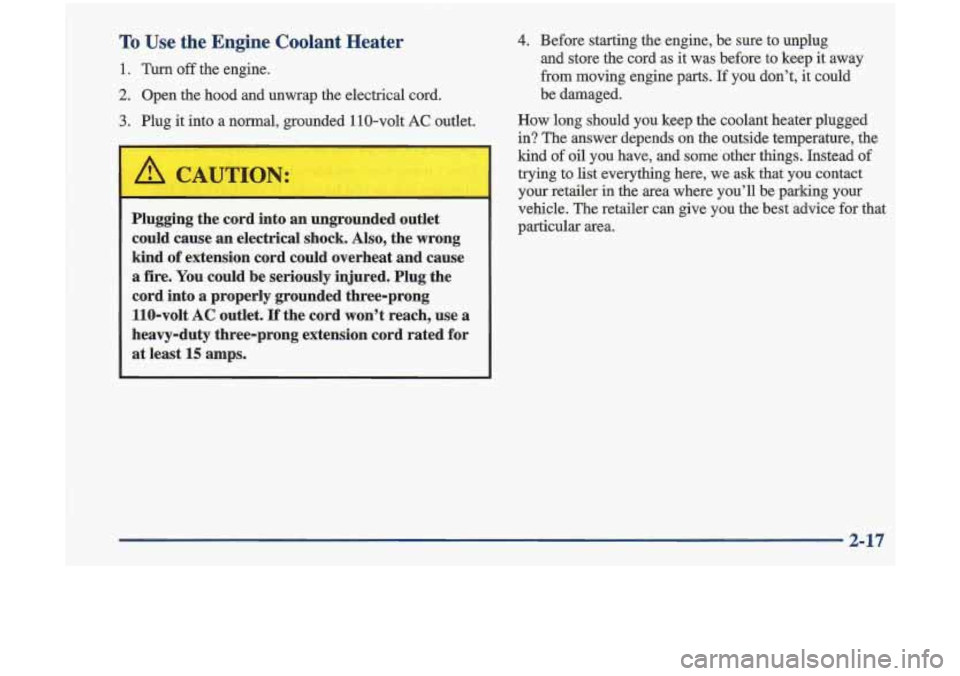
To Use the Engine Coolant Heater
1. Turn off the engine.
2. Open the hood and unwrap the electrical cord.
3. Plug it into a normal, grounded 110-volt AC outlet.
/1 CAUTION.
Plugging the cord into an ungrounded outlet
codd cause an electrical shock
Also, the wrong
kind of extension cord could overheat and cause
a fire. You could be seriously injured. Plug the
cord into a properly grounded three-prong
110-volt
AC outlet. If the cord won’t reach, use a
heavy-duty three-prong extension cord rated for
at least 15 amps.
4. Before starting the engine, be sure to unplug
and store the cord as it was before to keep it away
from moving engine parts.
E you don’t, it could
be damaged.
How long should you keep the coolant heater plugged
in? The answer depends
on the outside temperature, the
kind
of oil you have, and some other things. Instead of
trying to list everything here, we ask that you contact
your retailer
in the area where you’ll be parking your
vehicle. The retailer can give you the best advice for that
particular area.
2-17
Page 85 of 348
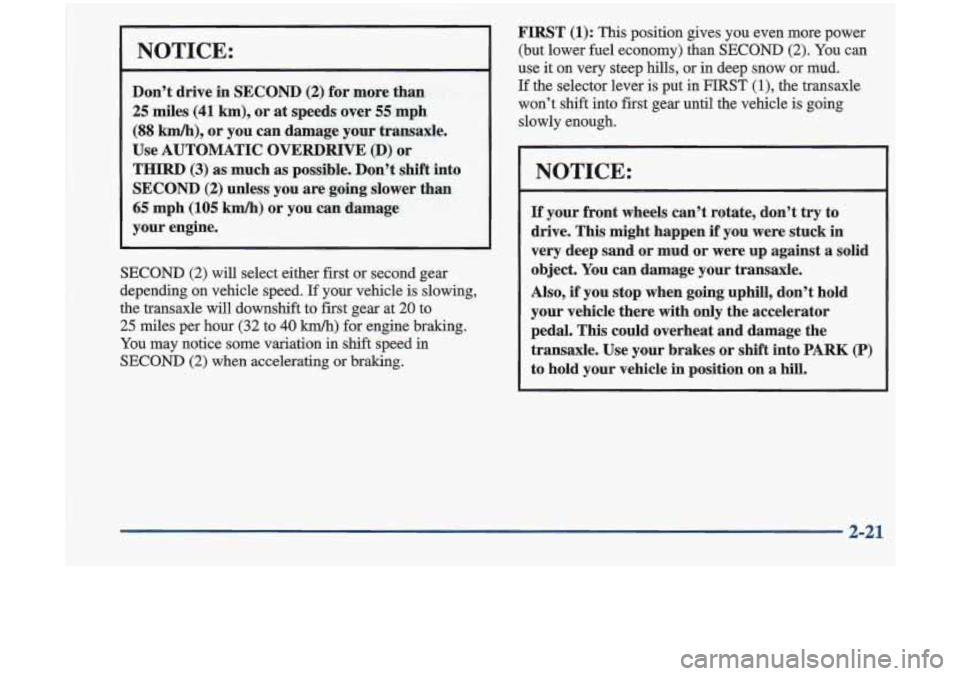
NOTICE:
Don’t drive in SECOND (2) for m,ore than
25 miles (41 km), or at speeds over 55 mph
(88 km/h), or you can damage your transaxle.
Use AUTOMATIC
OVERDRIVE (D) ‘or
THIRD (3) as much as possible. Don’t shift into
SECOND (2) unless you are going slower than
65 mph (105 kmk) or you can damage
your engine.
SECOND (2) will select either first or second gear
depending on vehicle speed. If your vehicle is slowing,
the transaxle will downshift to first gear at
20 to
25 miles per hour (32 to 40 km/h) for engine braking.
You may notice some variation in shift speed in
SECOND
(2) when accelerating or braking.
FIRST (1): This position gives you even more power
(but lower fuel economy)
than SECOND (2). You can
use it on very steep hills, or in deep snow or mud.
If the selector lever is put in FIRST (1)’ the transaxle
won’t
shift into first gear until the vehicle is going
slowly enough.
NOTICE:
If’ your front wheels can’t rotate, don’t try to
drive. This might happen if you were stuck in
very deep sand
or mud or were up against a solid
object. You can damage your transaxle.
Also,
if‘ you stop when going uphill, don’t hold
your vehicle there with only the accelerator
pedal. This could overheat and damage the
transaxle. Use your brakes or shift into PARK
(P)
to hold your vehicle in position on a hill.
Page 88 of 348
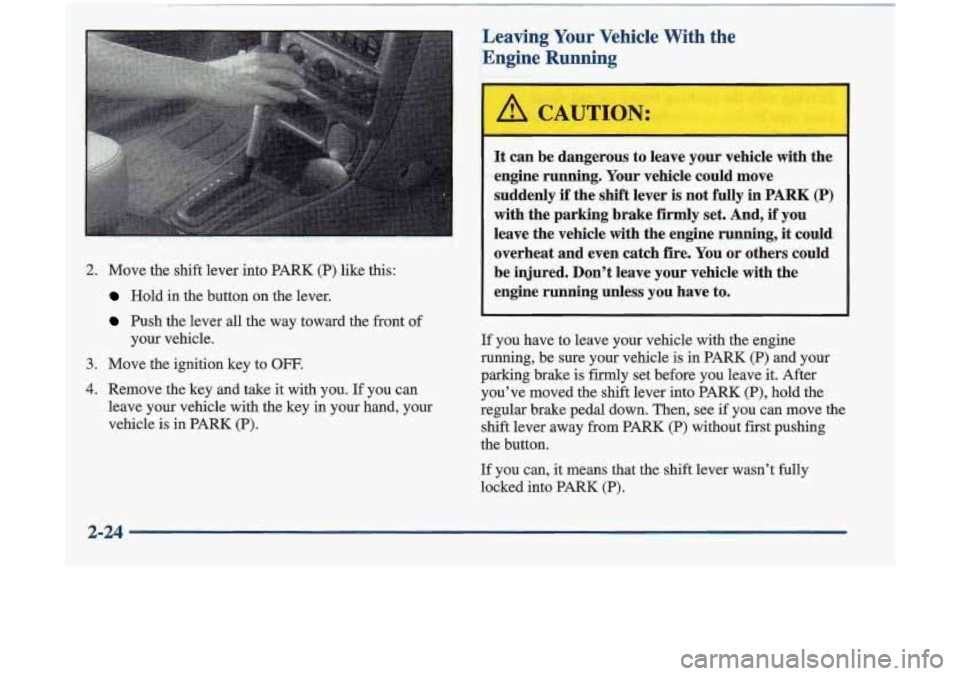
Leaving Your Vehicle With the
.;Engine Running
I
~ , . .. . - ~~~ ~ ,.-‘.“~‘,’7 ,2-- .v7.! jT.-<--. , . ~ , -
2. Move the shift lever into PARM (P) lilce this:
. . Hold jn the button on the lever.
Push the lever all the way toward the front of
your vehicle.
3. move the ignition key to OFF.
4. Remove the key and take it with you. If you can
leave your vehicle with the key in-your hand, your
veKcle
is in PARK (P).
It cm be dangerous to leave your vehicle with the
engine running. Your vehicle could move
suddenly if the shift lever
is not fully in PARK (P)
with the parking brake firmly set. And, if you
leave the vehicle
with the engine running, it could,
overheat and even catch fire. You
or others could
be.injured. Don’t leave your vehicle with the
engine
running unless you have to.
I
If you have to leave your vehicle with the engine
running, be sure your vehicle is in PARK (P) and your
parking brake is firmly set before
you leave it. After
you’ve moved the shift lever into
PARK (P), hold the
regular brake pedal down. Then, see
if you can move the
shift lever away from
PARK (P) without first pushing
the button.
If you can, it means that the shift lever wasn’t fully
locked into
PARK (p).
Page 118 of 348
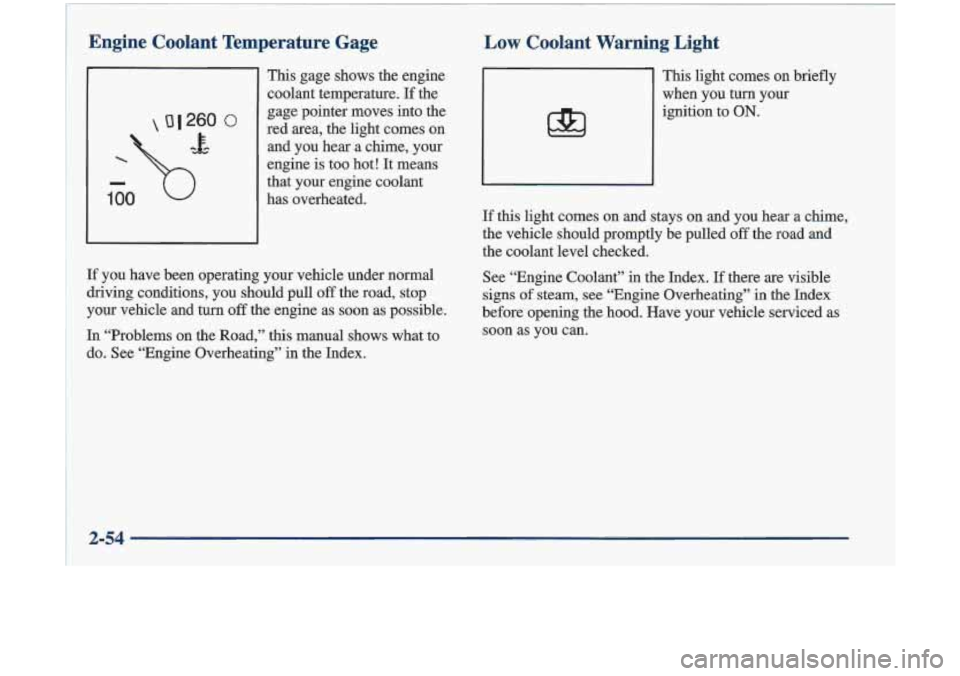
Low Coolant Warning Light
If you have been operating your vehicle under normal
driving conditions, you should pull
off the road, stop
your vehicle and
turn off the engine as soon as possible.
In “Problems on the Road,” this manual shows what to
do. See “Engine Overheating” in the Index.
m
This light comes on briefly
when you
turn your
ignition to
ON.
If this light comes on and stays on and you hear a chime,
the vehicle should promptly be pulled off the road and
the coolant level checked.
See “Engine Coolant” in the Index.
If there are visible
signs of steam, see “Engine Overheating” in the Index
before opening
the hood. Have your vehicle serviced as
soon as you can.
Page 184 of 348
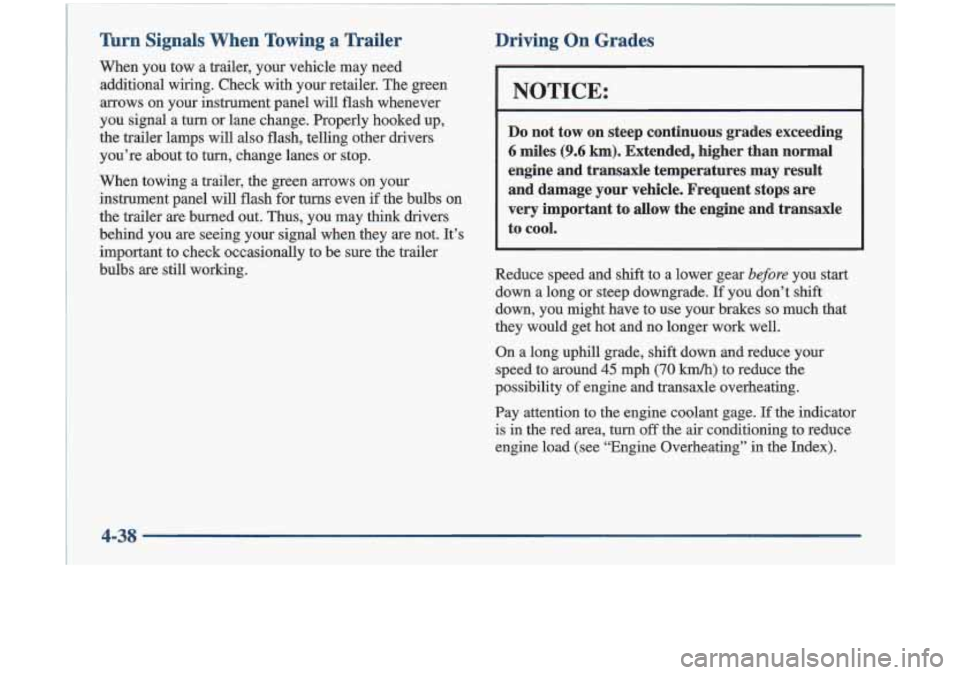
Turn Signals When Towing a Trailer
When you tow a trailer, your vehicle may need additional wiring. Check with your retailer. The green
arrows on your instrument panel will flash whenever
you signal a turn or lane change. Properly hooked up,
the trailer lamps will also flash, telling other drivers
you’re about to
turn, change lanes or stop.
When towing a trailer, the green arrows on your instrument panel
will flash for turns even if the bulbs on
the trailer are burned out. Thus, you may think drivers
behind you are seeing your signal when they are not. It’s
important to check occasionally to be sure the trailer
bulbs are still working.
Driving On Grades
NOTICE:
Do not tow on steep continuous grades exceeding
6 miles (9.6 km). Extended, higher than normal
engine and transaxle temperatures may result
and damage your vehicle. Frequent stops are
very important to allow the engine and transaxle
to cool.
Reduce speed and shift to a lower gear before you start
down a long or steep downgrade. If you don’t shift
down, you might have to use your brakes
so much that
they would get hot and no longer work well.
On a long uphill grade, shift down and reduce your
speed to around
45 mph (70 km/h) to reduce the
possibility
of engine and transaxle overheating.
Pay attention to the engine coolant gage. If the indicator
is in the red area, turn
off the air conditioning to reduce
engine load (see “Engine Overheating” in the Index).
4-38
Page 187 of 348
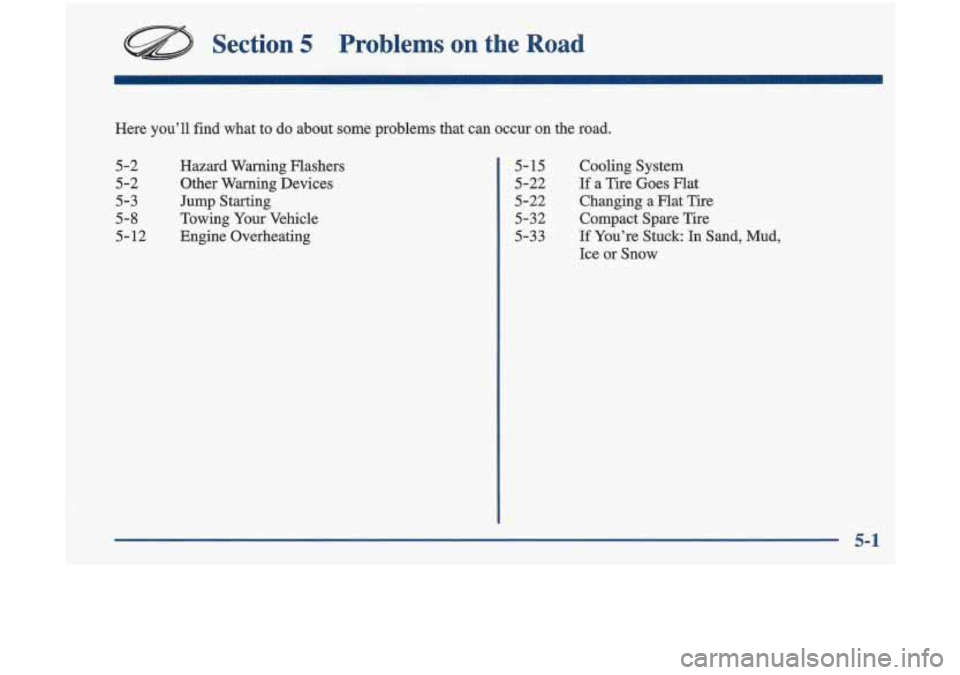
Section 5 Problems on the Road
Here you’ll find what to do about some problems that can occur on the road.
5-2
5-2
5-3
5-8
5-12
Hazard Warning Flashers Other Warning Devices
Jump Starting
Towing Your Vehicle
Engine Overheating 5- 15 Cooling System
5-22 Changing a Flat Tire
5-32 Compact Spare Tire
5-33 If You’re Stuck: In Sand, Mud,
5-22 If a Tire’Goes Flat
Ice or Snow
5-1
Page 198 of 348
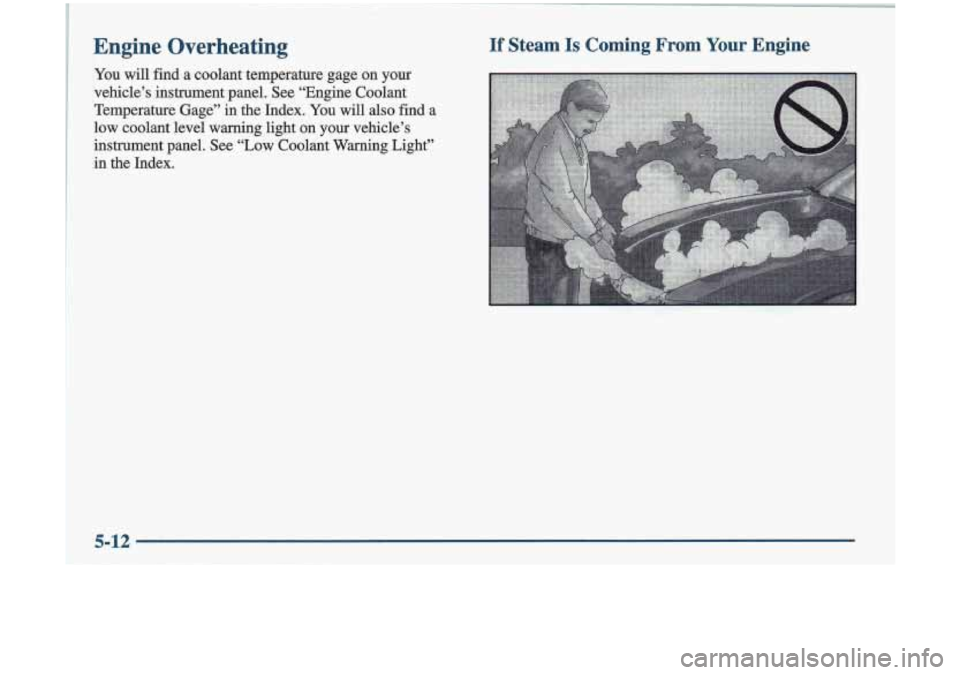
Engine Overheating
You will find a coolant temperab Ire gage on
vehicle’s instrument panel. see “Engine Coo
If Steam Is Coming From Your Engine
your
dant
Temperature Gage”
in the Index. You will also find a
low coolant level waming light on your vehicle’s
instrument panel. See
“LOW Coolant Warning Light”
in the Index.
5-12
Page 199 of 348
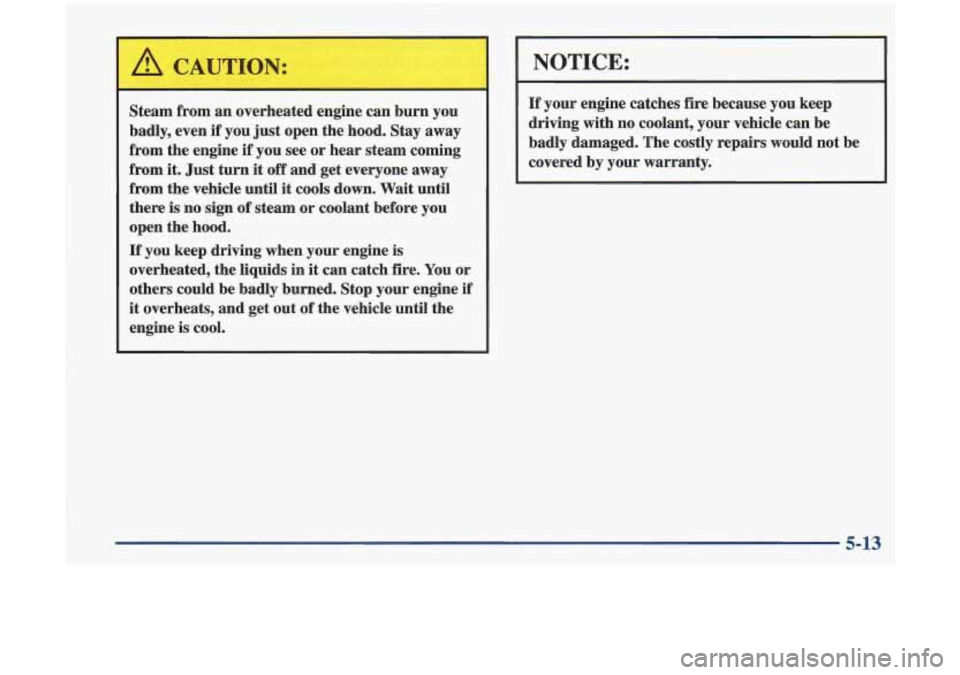
Steam from an overheated engine can burn you
badly, even if you just open the hood. Stay away
from the engine if you see or hear steam coming
from it. Just turn it off and get everyone away
from the vehicle until it cools down. Wait until
there is no sign of steam or coolant before you
open the hood.
If you keep driving when your engine is
overheated, the liquids in it can catch fire. You or
others could be badly burned. Stop your engine
if
it overheats, and get out of the vehicle until the
engine is cool.
~~ ~
NOTICE:
If your engine catches fire because you keep
driving with no coolant, your vehicle can be
badly damaged. The costly repairs would not be
covered by your warranty.
5-13
Page 200 of 348
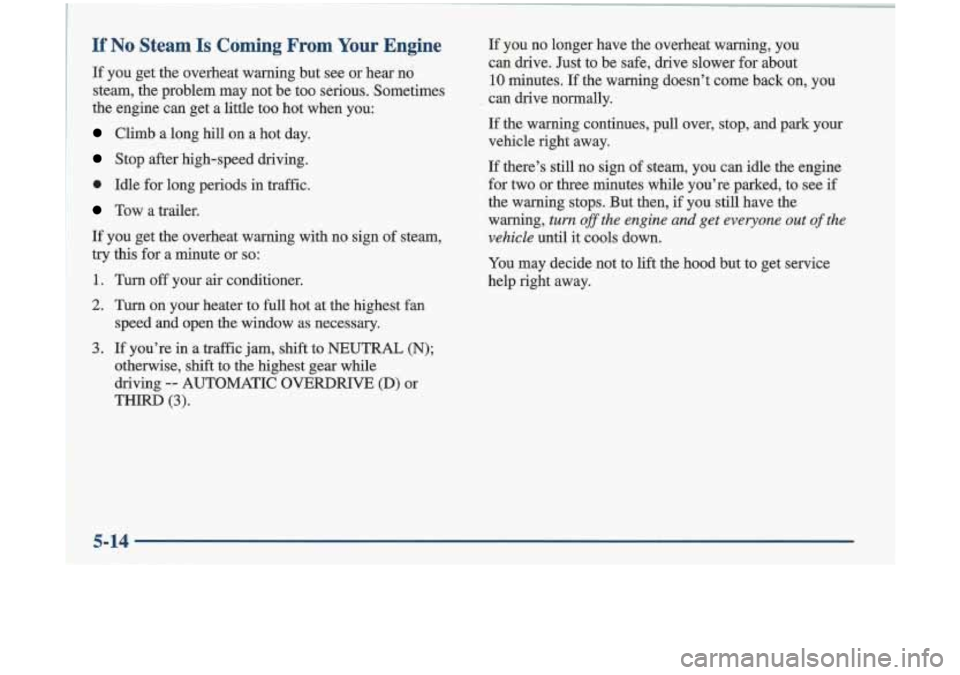
If No Steam Is Coming From Your Engine
If you get the overheat warning but see or hear no
steam, the problem may not be too serious. Sometimes
the engine can get a little too hot when you:
Climb a long hill on a hot day.
Stop after high-speed driving.
a Idle for long periods in traffic.
Tow a trailer.
If you get the overheat warning with no sign of steam,
try this for a minute
or so:
1. Turn off your air conditioner.
2. Turn on your heater to full hot at the highest fan
speed and open the window as necessary.
3. If you’re in a traffic jam, shift to NEUTRAL (N);
otherwise, shift to the highest gear while
driving
-- AUTOMATIC OVERDRIVE (D) or
THIRD
(3).
If you no longer have the overheat warning, you
can drive. Just to be safe, drive slower for about
10 minutes. If the warning doesn’t come back on, you
, can drive normally.
If the warning continues, pull over, stop, and park your
vehicle right away.
If there’s still no sign of steam, you can idle the engine
for
two or three minutes while you’re parked, to see if
the warning stops. But then, if you still have the
warning,
turn off the engine and get everyone out of the
vehicle
until it cools down.
You may decide not to lift the hood but to get service
help right away.
5-14
Page 202 of 348

The coalant level should be at or above FULL COLD
m-ark .or slightly higher.
If it isn’t, you may have a leak in the radiator hoses,
heater hoses, radiator, water
pump or somewhere else in
the cooling system.
Heater and radiator hoses, and other engine
parts, can be very hot. Don’t touch them.
If you
do, you can be burned.
Don’t run the engine
if there is a leak. If you run
the engine, it could lose all coolant. That could
cause
an engine fire, and you could be burned.
Get any leak fixed before you drive the vehicle.
1 NOTICE:
Engine damage from running your engine
without coolant isn’t covered by your warranty.
If there seems to be no leak, with the engine on, check to
see if the electric engine cooling fans are running.
If the
engine is overheating, both fans should be running.
If
they aren’t, your vehicle needs service.